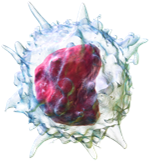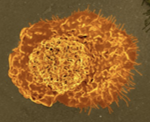immunology wars
may your immune system defend you
Monocytes / Macrophages

Monocytes develop in the bone marrow and then circulate in the blood; when recruited to body tissues monocytes become macrophages. Macrophage means "big eater" and along with neutrophils they make up the main phagocytic cells of the immune response. They are able to engulf and ingest pathogens and damaged, diseased or cancerous cells. Unlike neutrophils, which die after engulfing one pathogen, macrophages are able to destroy multiple cells or microbes.

Source: Blausen Medical (CC)
Tissue (resident) macrophages play a central role in recruiting cells to the site of infection or injury and help control the inflammatory response through the release of chemical messengers called cytokines. Macrophages are also professional antigen presenting cells and are able to "educate" T-lymphocytes about the specific nature of the threat that is being faced.

Source: NIAID (CC)
Some pathogens are able to survive being engulfed by macrophages and are not destroyed. These pathogens are then able to replicate inside the macrophages and thus hide from the rest of the immune system.
Cells
- Basophils
- Eosinophils
- Mast Cells
- Neutrophils
- Monocytes / Macrophages
- Natural Killer Cells
- Dendritic Cells
- B-Lymphocytes
- T-Lymphocytes
- CD4+ T-Lymphocytes
- CD8+ T-Lymphocytes
- Regulatory T-lymphocytes
- Th17 Lymphocytes
